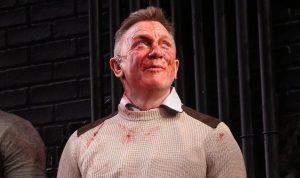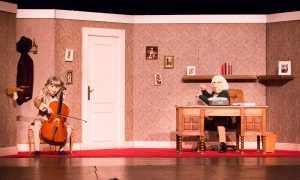
The prolific playwright Tom Stoppard has said Leopoldstadt will be his final play. He is now in his eighties having been a success since 1966’s Rosencranz and Guildenstern are Dead, an absurdist riff on two minor Shakespeare characters from Hamlet. This new play is a very personal work as all four of his grandparents died in a Nazi concentration camps.
Mr. Stoppard has set his play at intervals between 1899 and 1955. At the onset, a large extended family is gathered for the holidays. A tree is being decorated. This family traces its lineage to Leopoldstadt where years earlier they fled the Russian pogroms. Now settled comfortably in Vienna, they are prosperous and well-educated.
The story first follows this family through ordinary events such as relationships, children and business. The time period moves on to the impact of World War I through the Anschluss in 1938 when Germany annexed Austria. World War II follows. For a predominately Jewish family, the plot is not new and much of this history is known. The viewer, however, will face this broad historical outline in a very intimate setting.
The story naturally evolves from the depiction of family dynamics to the horrors which descend upon them. The audience is asked to bear witness and peer into a house and its people as they try to make sense of the unfolding chaos. What does one do? Are there options? Were warning signs heeded early enough?
There are obvious comparisons to be made between this period and our own. The vilification of certain peoples by the self-proclaimed betters. The throngs of Austrians who welcomed Hitler into their midst with celebratory reverence. That is certainly imagery we similarly witness today in undisguised fascist-like pro-Christian rallies. There is a lot to take in here and the play is exceptionally effective.
As with many Stoppard works, there are many lines which are memorable. In a scene set in 1924 one character comments that “the rational is at the mercy of the irrational”. Hard to not see the direct parallel there unless you choose to be intentionally blind or, more aggressively, a stoker of racial and religious hate and fear.
Since the play concludes in 1955 some characters will survive. A three person scene devastates in presenting morally complicated analyses and conflicting points of view. There is no doubt about what happened or that it was horrific. For the survivors there is only what’s next.
What is next? That question felt important to me when leaving this occasionally overlong one act play. (Uninterrupted sitting for 2:10 in the very uncomfortable seats of the Longacre Theatre is not ideal.) The first and last scenes did seem excessive in length. I will admit, however, that Mr. Stoppard deftly introduced an enormous cast, brought them to life and made us confront the demonic tendencies of the human race.
Leopoldstadt does what excellent theatrical dramas are supposed to do. It shines a light. Questions are asked. We can absorb the material and its impact on ourselves while imaging what that impact is for others. It educates and outrages us. And, honestly, it exhausted and haunted me. And scared me too.
Leopoldstadt is currently running on Broadway at the Longacre Theatre .










You must be logged in to post a comment.